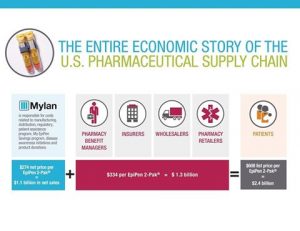Sometime last year, I was having a conversation with a Mylan sales representative who had come by the hospital to introduce herself and tell us about the anesthetic drugs Mylan was now producing. The conversation soon turned to their dynamic CEO, Heather Bresch. Regardless of how you feel about her, she has grown the company from a small generics company started in West Virginia to an international player, now based in Holland.
Imagine my surprise when I heard the venom being flung at her lately and somewhat deservedly over the Epipen price increases.
In 2007, Mylan bought a portfolio of drugs from the German firm, Merck kGaA. Among them was Epipen, an injector containing about $1 worth of epinephrine (adrenaline). It was developed years earlier as a way of treating anaphylactic reactions which can turn deadly rather quickly in patients with say, peanut or shellfish allergies or the bee stings. The injector was developed by a Sheldon Kaplan for the US Military years ago. At that time, it carried antidotes for nerve agents.
Ms Bresch, who was one of the VPs at Mylan in 2007, came up with a brilliant marketing strategy that has turned Epipen into a billion dollar revenue maker. She got Congress to legislate that all schools carry Epipen. She got Disney to stock Epipen in all it’s parks. She has even targeted cruise and airlines. In 2011, Mylan spent $4.8 million on ads, going up to $35 million in 2014.
The marketing campaign paid dividends. Use of Epipen has grown 67% in 7 years and 47 states mandate Eipen in all schools. In 2011,
In 2007, revenue form Epipen sales was $200 million. Sales in 2014 were $1.1 billion. That one drug is responsible for 40% of Mylan’s operating profit and that is saying something for a company that has about 1400 drugs in it’s portfolio. Margins for Epipen were 9% in 2008. In 2014, a whopping 55%.
Increasing revenues have been helped by increasing Epipen prices – the price for a set of two was about $57 in 2007, then $103. 50 in 2009 and $264.50 in July 2013. It rose by 75 percent to $461 by May 2015. This May, the price spiked again to $608.61.
It is easy to attribute the price increase to corporate greed and aggressive marketing, the cost of which is being transferred to the patient. You can even claim the Mylan has a monopoly and arcane FDA policies are to blame. The issue in producing a competing product is the injector and Mylan’s competitor’s have not been able to come up with a good one.
However, there is an even more disturbing issue at play here and this to me, epitomizes all that is wrong with healthcare in the US. The issue of too many players – too many middlemen.
Ms Bresch in an interview on CNBC earlier today showed a graphic about the Epipen supply chain. It showed all the middlemen and how the price goes from the $274 that Mylan charges to $608 at retail. Find it below:

The middlemen in this supply chain are the Pharmacy Benefit Managers (PBMs), the Insurers, the Wholesalers and finally the retailers.
What is a Pharmacy Benefits Manager (PMB)? An example is Express Scripts. These are companies who seek to negotiate cheaper drugs prices for the insurers.
Lets’ say Company A makes drug X. It wants to sell it for $40. A PMB on behalf of all insurers as well as the large corporations like Walmart or GM negotiates with Company A and gets the price to $25. For it’s work, it must get paid. The insurers add, say $10 to the $25 so they can pay the PMB. The drug is now $35. The insurers then commission Wholesaler C (eg McKesson), to get the drug to the retailers. Wholesaler C has to make a profit. The drug is not used by many people. It adds $15 to the $35. Now the drug is $50. The retailers get the drug. They need to make a profit too. They also slam on $20 and the patient now has to pay $70.
So when Mylan offers a rebate of $100 or even $300, it is attempting the cover the costs of the middlemen, so they will carry the drug! However since only about 6% of consumers ever take advantage of rebates, it does not really spend that much. Beside, the total cost of a the rebate program, even at $300 is only a fraction of the revenue generated by the drug.
And that is how drug costs keep escalating. And that is also a microcosm of the healthcare system in the US. In the health delivery supply chain are too many middlemen, all with their hands out for a dollar. Is it any wonder healthcare costs are so high?
I dare say it’s not only our patients who are suffering from obesity. The whole damn system is morbidly obese and needs to lose weight or really soon, things will come to a standstill.
